Rann Utsav 2025-26: Dates, Tickets & First-Time Visitor’s Travel Guide
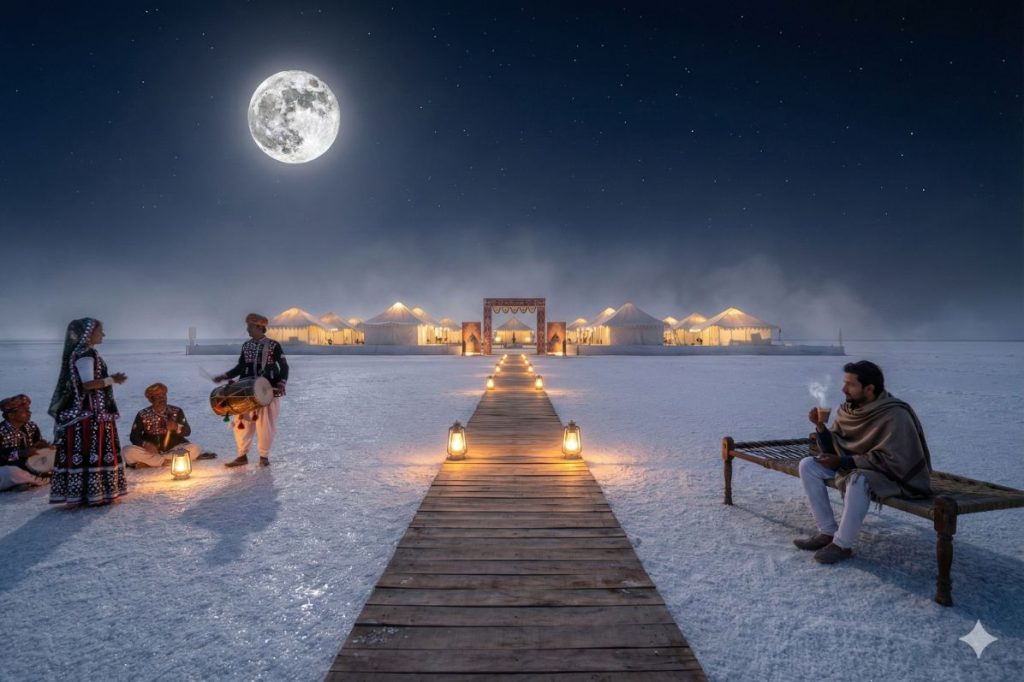
Introduction Rann Utsav is truly a magical festival. The festival takes place in a remote desert area known as Rann of Kutch. The desert has very few inhabitants and is home to many ethnic groups. While you stand on a flat, white salt pan looking up at the stars, you hear the sound of traditional folk music playing in the background as you drink hot spiced tea called chai from a tent set up beside the tent where artisans sell their wares. You are surrounded by artisans who sell their goods, including colourful clothing and other beautiful handicrafts. You can also smell the delicious, traditional dishes being served at food stalls all around the festival. If this is your first time visiting, this guide will help you with: Official 2025 festival dates & booking tips How to reach the desert and where to stay What the Tent City experience includes Best travel windows, costs, and practical tips In Short – Key Takeaways Festival Period: 23 Oct 2025 to 4 Mar 2026 Best months to visit: November to February – pleasant desert climate & full-moon nights Getting there: Fly or train to Bhuj → 80 km / ~1.5–2 hr road to Dhordo Tent City Why go: White-salt desert under full-moon, cultural shows, folk art & crafts, desert adventure under stars What Is Rann Utsav? Rann Utsav is a winter festival hosted in the Kutch’s Rann region, where there is a large expanse of white salt deserts. When illuminated by the moonlight, this vast desert transforms into a dream-like white scene. During the festival’s existence, it has evolved into a combination of several aspects including nature, culture, adventure, and hospitality. This festival provides an opportunity for travelers who want to do something different than visit beaches or populous areas. What to Expect at Rann Utsav A temporary Tent City at Dhordo offering varied accommodation from simple tents to premium cottages Cultural nights with folk music, traditional dance, local cuisine, and handicraft bazaars showcasing Kutchi art & textiles Desert adventures: camel rides, ATV/buggy rides, paramotoring, night desert safaris, sunrise & sunset visits to the White Desert White-salt plains glowing under full-moon – a surreal photography & stargazing experience For many, Rann Utsav is a chance to experience Gujarat’s heritage, desert beauty, and local hospitality all at once. Rann Utsav 2025 Dates & Schedule The 2025-26 edition of Rann Utsav runs from 23 October 2025 to 4 March 2026. Period What to Expect Late Oct – Early Nov Festival kickoff; moderate crowds; first full-moon nights after monsoon November – February (Peak) Best time – clear skies, comfortable weather, full-moon nights, maximum cultural events & tent occupancy March (early) Festival wind-down; fewer crowds, cooler desert mornings, ideal for budget travelers Best months to visit: November, December, January – when the weather is pleasant, nights are cool, and the desert under moonlight is magical. Pro tip: For a jaw-dropping experience, aim for full-moon nights – the salt desert reflects moonlight beautifully, creating a surreal, dream-like landscape. Location & How to Reach Rann Utsav Where is it Held? The festival is held at Dhordo Tent City, set at the edge of the White Salt Desert in Kutch, Gujarat. How to Reach Mode Details By Air Fly into Bhuj Airport (BHJ) – nearest airstrip to Rann Utsav By Train Reach Bhuj Railway Station, well connected to major cities; then travel by road From Bhuj to Dhordo ~80 km / ~1.5–2 hours by road. Taxi, shuttle or pre-arranged transfer recommended Typical travel cost (road transfer from Bhuj): modest – especially if using shared taxi or shuttle services. If you come via major cities like Ahmedabad, Mumbai or Delhi, you can combine flight/train to Bhuj + road transfer for a smooth journey. Why Rann Utsav Should Be On Your Travel Radar If you’re looking for a travel experience unlike beaches, hills or cities – Rann Utsav offers a magical mix: A salt-desert transformed into a cultural festival under a blanket of stars Rustic tents & ethnic vibes that bring you close to local culture Adventure + calm: desert safaris by day, folk music under moonlight by night Affordable for Indian travellers – budget friendly compared to international trips Whether you’re travelling solo, with family or friends, Rann Utsav gives a slice of surreal beauty, culture, and adventure – all wrapped into one experience. For travellers who enjoy global seasonal festivals, this could be India’s most unique winter escape – something akin to a desert festival crossed with a cultural carnival. Rann Utsav Tent City & Accommodation Guide When you arrive at Rann Utsav, you stay at the well-managed Tent City at Dhordo. Here’s what you need to know about accommodation and tent city booking. Types of Tents & Facilities Rann Utsav tent options range from budget-friendly to premium luxury. Choices include: Tent Type / Class Key Features Non-AC / Basic Tent or Swiss Cottage Simple tent or cottage with fan or basic ventilation, twin beds or single, attached bathroom – budget friendly. Deluxe AC / AC Swiss Cottage Air-conditioned or well-ventilated, attached bathroom, comfortable beds and amenities – mid-range comfort. Premium Tent Bigger space, typically better interiors, AC, front porch – good balance of comfort & value. Super Premium / Luxury / “Darbari / Rajwadi Suite” Highest level comfort: AC, premium furnishings, possibly more space or suite-style amenities for couples or those wanting luxury. All tent-city stays usually include meals, access to cultural evenings & festival-related shows, and proximity to the desert/sunset-point for night desert & full-moon experiences. Tip for selection: If you’re on a budget or travelling solo or as backpackers → choose Non-AC / Deluxe tent. For families, couples or comfort-seekers → Premium or Super Premium tent works best. For travellers after full comfort + extras (AC, privacy, luxury) → go for the luxury suite tent option. Rann Utsav Tickets & Tent City Prices (2025–26) Here’s a breakdown of typical tent-city pricing and inclusions. Actual tariff may vary based on dates (full-moon nights, holidays, demand), so
Top International Destinations for New Year Celebrations
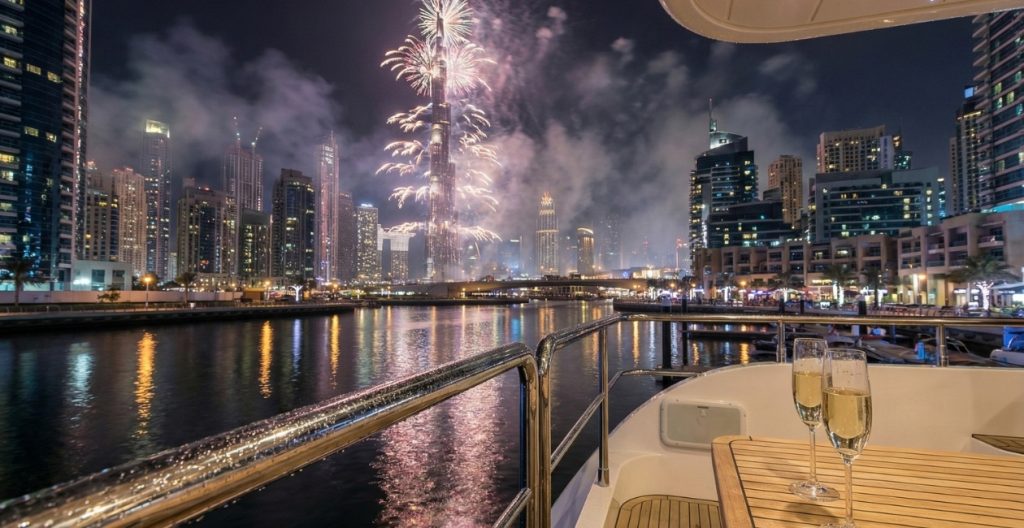
Across the globe, many of us around the world celebrate New Year’s Eve as one of our most cherished and exciting dates each year. This is the date filled with celebrations, fireworks, countdowns, large crowds of people celebrating, and amazing memories. If you are thinking about planning on going away for New Years this coming season, this is a perfect opportunity to travel to some of the most famous and best cities or holiday spots in the world. No matter where you are traveling to (Australia, America, Asia) there are astounding displays of fireworks being held in cities like Sydney, Dubai, etc., as well as romantic date nights in locations like Paris and the Maldives, as well as festive street parties being held in locations like Bangkok and New York City – the ways in which we all celebrate the New Year are limitless!! If your travel plans are for a luxury getaway, budget-friendly trip away for New Years, a family vacation away for New Years, or a Romantic Vacation away to Celebrate New Year’s, there are a ton of amazing options out there for you! International travel is becoming more and more common due to trends related to international tourism and the growing number of countries that are now offering the ability to enter their country with a quick and easy visa as well as their festive travel offerings/travel packages will contribute to making international travel for New Year 2025 one of the top Holiday Choices as well. Why Celebrate New Year Abroad? Celebrating New Year outside India is not just a vacation – it’s an experience packed with energy, culture, emotion, and celebration. Here’s why travellers are choosing global destinations: Iconic Fireworks & Countdown Events – Burj Khalifa, Sydney Harbour, NYC Times Square, London Thames Beach Parties & Warm Winter Destinations – Bali, Phuket, Maldives, Singapore Romantic New Year Getaways – Paris, Santorini, Maldives, Swiss Alps Family-Friendly Celebrations & Festivals – Singapore, Dubai, Sydney, London Unique Cultural New Year Traditions – Japan, Spain, Hong Kong, Vietnam World-Class Nightlife & Parties – Bangkok, Amsterdam, Miami, Rio Better Travel Accessibility – More direct flights, travel packages, visa-on-arrival options Traveling abroad for New Year gives you a chance to begin the year in a new place, with new memories and inspiration – perfect for couples, families, solo travelers, and groups alike. Travel Trends for New Year 2025 Based on global travel forecasts and booking patterns: International New Year travel is expected to rise by 30–40% in 2025, especially among young Indian travellers and families Dubai, Singapore, Sydney, and Bali are among the top trending choices due to availability of Visa-on-Arrival / easy visas Affordable New Year destinations like Vietnam, Sri Lanka, Nepal, and Turkey are gaining huge popularity People are booking earlier than ever – 4–6 months in advance to secure flights and hotels at good rates Experiential trips (cruises, rooftop countdown parties, concerts, cultural festivals) are becoming more desirable than traditional travel Demand for customized and group holiday packages is rapidly growing, making New Year 2025 one of the biggest travel seasons Key Highlights Best global cities for New Year fireworks: Dubai, Sydney, New York, London Warm winter & beach celebrations: Bali, Maldives, Phuket, Goa Best places for nightlife & parties: Bangkok, Amsterdam, Miami Romantic escapes for couples: Paris, Santorini, Maldives Family-friendly destinations: Singapore, Dubai, Sydney Budget picks: Vietnam, Sri Lanka, Nepal, Turkey Book 4–6 months early for best prices Choose based on weather, visa, budget & travel style Top 10 International Destinations for New Year Celebrations 1. Dubai, UAE – The World’s Most Iconic New Year Fireworks Dubai remains one of the best international destinations for New Year celebrations, famous for its larger-than-life fireworks at Burj Khalifa, Palm Jumeirah, and Burj Al Arab. The entire city turns into a festival ground with concerts, luxury cruises, beach parties, desert gala nights and spectacular lighting across the skyline. Who should visit? Couples – Romantic dinner cruises at Dubai Marina, rooftop celebrations Families – Kid-friendly events, theme parks, fireworks views from beaches Party Lovers – Nightclubs, beach concerts & DJ nights Budget Travellers – Free public fireworks at Dubai Mall & Jumeirah Beach Luxury – Private yacht parties, Atlantis gala, five-star resort events Best Experience: Countdown at Burj Khalifa Fountain Show + Dinner cruise at Marina Best Time to Book: 3–5 months in advance Want a personalized New Year package with cruise or yacht options? The Tarzan Way helps plan curated Dubai experiences with airport-to-airport support and visa assistance. 2. Singapore – Family-Friendly Countdown by the Bay Singapore is perfect for travellers looking for a safe, clean, and beautifully organized New Year experience. The highlight is the New Year Marina Bay Countdown, one of Asia’s largest fireworks and laser light shows. Who should visit? Families – Universal Studios, Sentosa Island, SEA Aquarium Couples – Romantic sky-views from Marina Bay Sands, night cruise dinners Party lovers – Clarke Quay, Siloso Beach Party, rooftop bars Budget friendly – Chinatown & Gardens by the Bay light show (free entry) Special Experiences: Garden Rhapsody at Gardens by the Bay Cable car dinner with stunning skyline views Cruise countdown at Clarke Quay Singapore is a top choice for easy visa + quick weekend getaway from India, making it popular among families and first-time travellers. If you’re planning New Year travel combos like Singapore + Malaysia, The Tarzan Way can help design the perfect itinerary. 3. Sydney, Australia – The First Major City to Enter the New Year Sydney offers one of the most televised New Year celebrations in the world, with fireworks illuminating the Sydney Harbour Bridge and Opera House. Watching the fireworks reflected on water is a once-in-a-lifetime memory. Who should visit? Couples – Harbour cruise + opera dinner Families – Accessible viewpoints & parks Party travellers – Darling Harbour clubs & beach parties Budget – Free views from Mrs Macquarie’s Point Unique Experiences: Midnight fireworks cruise Bondi & Manly Beach parties Helicopter views of fireworks Sydney is perfect for people who want a stand-out,
Rann Utsav 2025-26: Dates, Tickets & First-Time Visitor’s Travel Guide
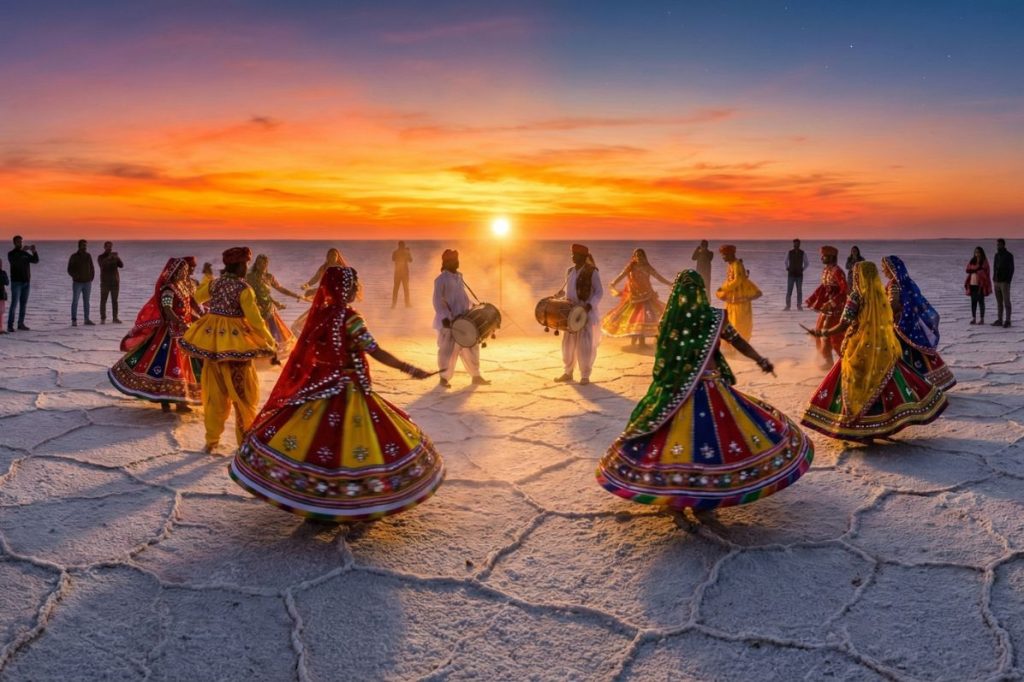
Introduction Rann Utsav is truly a magical festival. The festival takes place in a remote desert area known as Rann of Kutch. The desert has very few inhabitants and is home to many ethnic groups. While you stand on a flat, white salt pan looking up at the stars, you hear the sound of traditional folk music playing in the background as you drink hot spiced tea called chai from a tent set up beside the tent where artisans sell their wares. You are surrounded by artisans who sell their goods, including colourful clothing and other beautiful handicrafts. You can also smell the delicious, traditional dishes being served at food stalls all around the festival. If this is your first time visiting, this guide will help you with: Official 2025 festival dates & booking tips How to reach the desert and where to stay What the Tent City experience includes Best travel windows, costs, and practical tips In Short – Key Takeaways Festival Period: 23 Oct 2025 to 4 Mar 2026 Best months to visit: November to February – pleasant desert climate & full-moon nights Getting there: Fly or train to Bhuj → 80 km / ~1.5–2 hr road to Dhordo Tent City Why go: White-salt desert under full-moon, cultural shows, folk art & crafts, desert adventure under stars What Is Rann Utsav? Rann Utsav is a winter festival hosted in the Kutch’s Rann region, where there is a large expanse of white salt deserts. When illuminated by the moonlight, this vast desert transforms into a dream-like white scene. During the festival’s existence, it has evolved into a combination of several aspects including nature, culture, adventure, and hospitality. This festival provides an opportunity for travelers who want to do something different than visit beaches or populous areas. What to Expect at Rann Utsav A temporary Tent City at Dhordo offering varied accommodation from simple tents to premium cottages Cultural nights with folk music, traditional dance, local cuisine, and handicraft bazaars showcasing Kutchi art & textiles Desert adventures: camel rides, ATV/buggy rides, paramotoring, night desert safaris, sunrise & sunset visits to the White Desert White-salt plains glowing under full-moon – a surreal photography & stargazing experience For many, Rann Utsav is a chance to experience Gujarat’s heritage, desert beauty, and local hospitality all at once. Rann Utsav 2025 Dates & Schedule The 2025-26 edition of Rann Utsav runs from 23 October 2025 to 4 March 2026. Period What to Expect Late Oct – Early Nov Festival kickoff; moderate crowds; first full-moon nights after monsoon November – February (Peak) Best time – clear skies, comfortable weather, full-moon nights, maximum cultural events & tent occupancy March (early) Festival wind-down; fewer crowds, cooler desert mornings, ideal for budget travelers Best months to visit: November, December, January – when the weather is pleasant, nights are cool, and the desert under moonlight is magical. Pro tip: For a jaw-dropping experience, aim for full-moon nights – the salt desert reflects moonlight beautifully, creating a surreal, dream-like landscape. Location & How to Reach Rann Utsav Where is it Held? The festival is held at Dhordo Tent City, set at the edge of the White Salt Desert in Kutch, Gujarat. How to Reach Mode Details By Air Fly into Bhuj Airport (BHJ) – nearest airstrip to Rann Utsav By Train Reach Bhuj Railway Station, well connected to major cities; then travel by road From Bhuj to Dhordo ~80 km / ~1.5–2 hours by road. Taxi, shuttle or pre-arranged transfer recommended Typical travel cost (road transfer from Bhuj): modest – especially if using shared taxi or shuttle services. If you come via major cities like Ahmedabad, Mumbai or Delhi, you can combine flight/train to Bhuj + road transfer for a smooth journey. Why Rann Utsav Should Be On Your Travel Radar If you’re looking for a travel experience unlike beaches, hills or cities – Rann Utsav offers a magical mix: A salt-desert transformed into a cultural festival under a blanket of stars Rustic tents & ethnic vibes that bring you close to local culture Adventure + calm: desert safaris by day, folk music under moonlight by night Affordable for Indian travellers – budget friendly compared to international trips Whether you’re travelling solo, with family or friends, Rann Utsav gives a slice of surreal beauty, culture, and adventure – all wrapped into one experience. For travellers who enjoy global seasonal festivals, this could be India’s most unique winter escape – something akin to a desert festival crossed with a cultural carnival. Rann Utsav Tent City & Accommodation Guide When you arrive at Rann Utsav, you stay at the well-managed Tent City at Dhordo. Here’s what you need to know about accommodation and tent city booking. Types of Tents & Facilities Rann Utsav tent options range from budget-friendly to premium luxury. Choices include: Tent Type / Class Key Features Non-AC / Basic Tent or Swiss Cottage Simple tent or cottage with fan or basic ventilation, twin beds or single, attached bathroom – budget friendly. Deluxe AC / AC Swiss Cottage Air-conditioned or well-ventilated, attached bathroom, comfortable beds and amenities – mid-range comfort. Premium Tent Bigger space, typically better interiors, AC, front porch – good balance of comfort & value. Super Premium / Luxury / “Darbari / Rajwadi Suite” Highest level comfort: AC, premium furnishings, possibly more space or suite-style amenities for couples or those wanting luxury. All tent-city stays usually include meals, access to cultural evenings & festival-related shows, and proximity to the desert/sunset-point for night desert & full-moon experiences. Tip for selection: If you’re on a budget or travelling solo or as backpackers → choose Non-AC / Deluxe tent. For families, couples or comfort-seekers → Premium or Super Premium tent works best. For travellers after full comfort + extras (AC, privacy, luxury) → go for the luxury suite tent option. Rann Utsav Tickets & Tent City Prices (2025–26) Here’s a breakdown of typical tent-city pricing and inclusions. Actual tariff may vary based on dates (full-moon nights, holidays, demand), so
The Ultimate Guide to the Shimla to Manali Road Trip
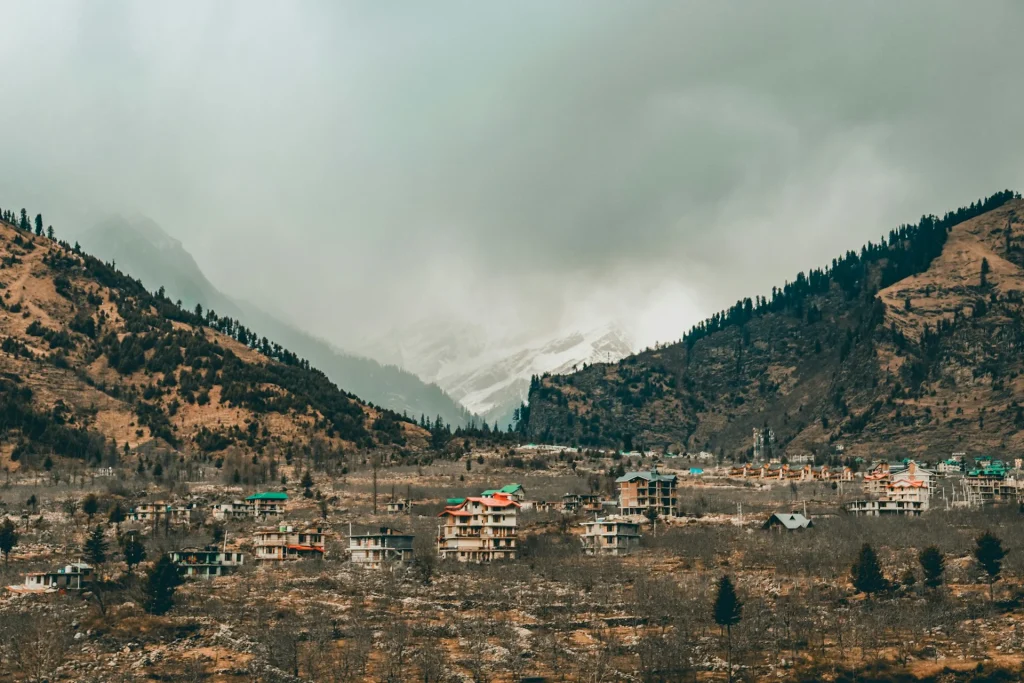
Beginning — The Call of the Himalayan Road The scenic highway from Shimla to Manali is a road tripper’s dream come true. It has winding paths framed by tall, snow-capped peaks, colorful villages, and charming roadside cafes serving hot momos. This famous road in northern India is more than just a way to get from one famous hill station to another; it’s an epic journey in its own right. It gives you nonstop beautiful views of the foothills of the Himalayas, with the turquoise Beas River always by your side, cutting through lush valleys. The 240-kilometer drive can be done in one long day, but it’s best to take your time and enjoy the culture, adventure, and food along the way over two, three, or even four days. This guide is the best thing you can bring with you on that trip. We will begin in the colonial charm of Shimla, then visit all the important stops along the way, from the quiet beauty of Naggar to the busy valley of Kullu. Finally, we will reach Manali, the adventure capital of the north. The Tarzan Way brings immersive storytelling journeys to life, turning this drive from a simple transfer into a rich cultural expedition, revealing hidden gems and local stories at every turn. Are you ready to pick up the phone? Let’s plan the best road trip through the Himalayas. Important Points The Route: A 240-kilometer drive (about 8 to 10 hours) that connects two of Himachal’s most well-known hill stations. Best to do over two or three days. Shimla is the starting point. You can learn about colonial history, visit The Ridge, Jakhoo Temple, and the UNESCO Kalka-Shimla Toy Train. The Journey: The drive itself is a draw, as it goes along the Beas River through towns like Kullu and Naggar. Key Stops: Kullu is great for river rafting, Naggar has a historic castle, and Manikaran has holy hot springs. Destination (Manali): a place for adventure and culture, with paragliding in Solang Valley, the Hadimba Temple, and Old Manali’s cafes. Important Planning: You need a Rohtang Pass Permit. Because of the risk of landslides, don’t take this route during the peak monsoon season (July to August). Be a responsible traveler: this ecosystem is very delicate. Working with guides like The Tarzan Way makes sure that your trip is safe and responsible. Shimla: The Beginning of the Colonies Credit: Unsplash Shimla, the “Queen of Hills” and the former summer capital of British India, is where your road trip starts. This city is the perfect first stop. It’s a great place to get used to the area and learn about its history before you go deeper into the mountains. Its neo-Gothic buildings and pedestrian-friendly streets give it an old-world charm that makes for a relaxing start to your trip. The Ridge and Mall Road This is the most important part of Shimla. The Ridge is a big, open-air platform that lets you see the Shivalik mountain ranges from all sides. On either side are Christ Church, the State Library, and a row of stores. Mall Road, a street without cars, is just below it and is full of life. It’s a great place to take a leisurely walk, buy souvenirs, and enjoy the lively atmosphere. Jakhoo Temple This old temple is on top of Jakhoo Hill, the highest peak in Shimla. It is dedicated to Lord Hanuman, the monkey god. There is a huge statue of the god that is 108 feet tall and can be seen from most of the city. There are two ways to get there: a beautiful hike or the “Jakhoo Gondola,” which is a cable car that gives you amazing views from above. Toy Train from Kalka to Shimla The trip to Shimla can be part of the fun. If you’re coming from Kalka (near Chandigarh), leave your car behind and take this train, which is a UNESCO World Heritage Site. This narrow-gauge railway, which was an engineering marvel at the time, goes through 103 tunnels, over 800 bridges, and offers stunning views of the forested hills. Tips for Travelers Jakhoo Monkeys: At Jakhoo Temple, be very careful with your things, like your phone, sunglasses, and food. Everyone knows that the monkeys that live there are very naughty. Booking a Toy Train: During peak season, tickets for the toy train sell out weeks or even months in advance. You can book online through the IRCTC website. Best Views: For the best pictures of the Himalayan skyline, go to The Ridge during the “golden hour,” which is either sunrise or sunset. Quick Facts The height of Shimla is 2,276 meters (7,467 feet). The Ridge, Kalka-Shimla Railway, and colonial architecture are some of the things that make it famous. Sita Ram & Sons for Chana Bhatura and Indian Coffee House for a nostalgic feel are two places you have to eat. The Journey: Driving on the Shimla-Manali Highway The trip from Shimla to Manali is a lot of fun. You will start by going down from Shimla’s heights and eventually meet the Beas River, which will guide you most of the way to Manali. The roads wind through tall pine forests, pass through small villages, and have many places where you can stop and take pictures of the beautiful scenery. Route and Conditions: NH 205 and NH 3 are the main roads that lead to it. The distance is only about 240 km, but it takes 8 to 10 hours to drive because the roads are winding and there may be traffic. That’s why it’s a good idea to stop along the way. What Makes It Popular with Travelers? The trip is the goal. The pine and deodar forests of the Shimla area give way to the more rugged, open, and beautiful valley of Kullu-Manali. Important Stops Along the Way: Kullu, Naggar, and More Credit: Unsplash Take your time on this drive. The towns and villages between Shimla and Manali are interesting in their own right, each
Beyond the Pink: The Ultimate Guide to Jaipur That No One Knows About
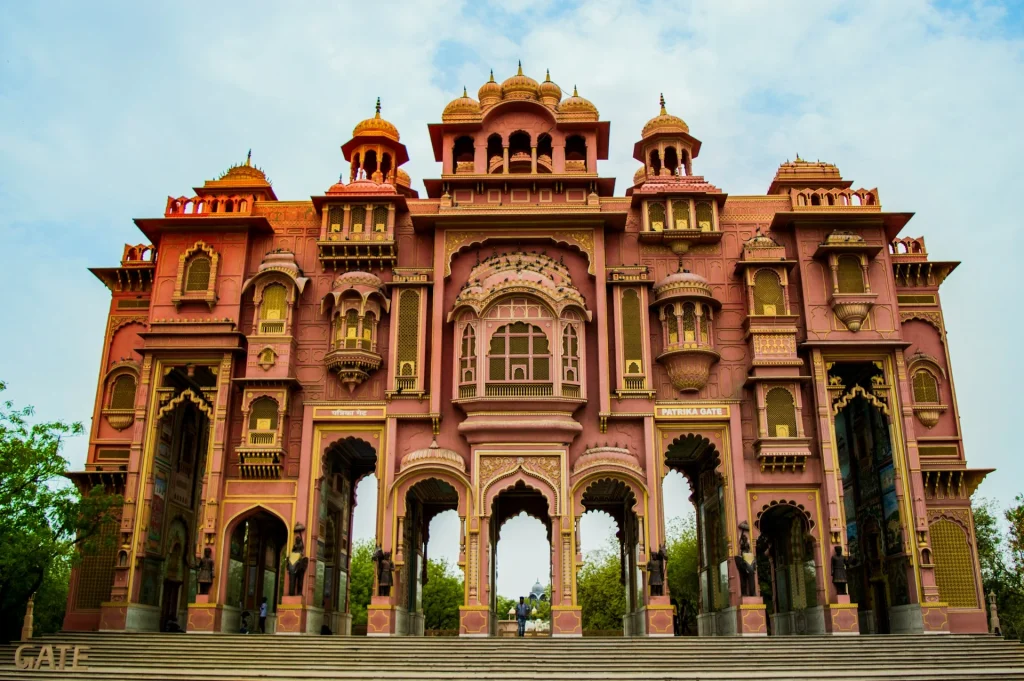
The Secrets of the Pink City: An Introduction Jaipur, the beautiful capital of Rajasthan, is a colourful, cultural, and royal city. The Pink City’s grand forts, opulent palaces, and vibrant bazaars are legendary, drawing travelers into a storybook of maharajas and empires. But there is more to Jaipur than just Hawa Mahal and Amer Fort. It has peaceful gardens made for a beloved queen, holy temples full of monkeys, old stepwells with impossible shapes, and urban forests where leopards roam. This guide will help you figure out those mysteries. We’ll take off the tourist trail’s layers to show you the lesser-known treasures that are often right in front of you, giving you a deeper, more personal look at Jaipur’s true soul. These are the places that tell a different story, one of love, spirituality, amazing architecture, and wild nature. The Tarzan Way makes immersive storytelling journeys possible, allowing travellers to go beyond the obvious and connect with the living history and hidden corners of Jaipur in a way that is both meaningful and memorable. Are you ready to see the Jaipur that most tourists don’t see? Let’s go look around. Important Points Beyond the Forts: This guide reveals 10 of Jaipur’s best-kept secrets, including royal gardens, old stepwells, and urban leopard safaris. A Different View: Check out architectural wonders like Panna Meena Ka Kund and Gaitore Ki Chhatriyan, which are great places to take pictures without the crowds. Find peace at the sacred Galta Ji Temple (The Monkey Temple) and the 17th-century Jagat Shiromani Temple. Nature in the City: Visit the amazing Jhalana Leopard Safari Park, Chandlai Lake, which is a birdwatcher’s paradise, and Asia’s largest circular park. Cultural Immersion: Don’t just shop at Bapu Bazaar; check out the Anokhi Museum, which is all about the art of block printing. Helpful Tips: Each location has important “Traveler’s Tips” on when to go, how to act, and how to get the most out of your visit. Sisodia Rani Ka Bagh: A Love Garden for Royals Credit: Unsplash Sisodia Rani Ka Bagh stands out as a peaceful oasis in the rough terrain of the Aravalli Hills. Maharaja Sawai Jai Singh II had this beautiful multi-tiered garden built in 1728 for his second wife, a princess from the Sisodia, Udaipur. It was a gift of love, a place for her to get away from the court. The way the garden is laid out is a perfect mix of Mughal and Rajput styles. There are several terraces with cascading water channels, fountains, and pavilions on them. The walls are covered in colourful murals that show scenes from the life of Lord Krishna, which show how much the queen loved him. It’s a lovely place to get away from the noise of the city, and it’s often hidden by the city’s bigger buildings. Advice for Travellers If you’re driving from Agra, this garden is right on the way, so it’s a great first stop. You can also easily visit both sites in one trip because they are so close to each other. The best times to go are early in the morning or late in the afternoon, when the light is soft and the mood is calm. Quick Facts The Maharaja Sawai Jai Singh II built it in 1728. Architecture: A mix of Mughal (Charbagh) and Rajput styles Location: 8 km from Jaipur on the road to Agra What it’s known for: its romantic history, beautiful murals, and calm atmosphere The Sacred Monkey Temple is called Galta Ji Temple Credit: Unsplash Galta Ji Temple is a peaceful and spiritual place that is hidden away in a rocky gorge just outside the city. The Monkey Temple is a famous Hindu pilgrimage site that is built into the Aravalli Hills. There are a lot of temples, pavilions, and, most importantly, seven kunds (water tanks) that are fed by natural springs. The main attraction is the natural spring that flows from the top of the hill and fills a series of sacred pools. Pilgrims come to these pools to bathe in the holy water. The temple is surrounded by rocky hills and has a peaceful feel to it. There are hundreds of rhesus macaques in the area, and they are considered sacred. This is why the temple is known by this name. Tips for Travellers Be Monkey-Aware: Don’t carry food in plain sight. Make sure your bags, phones, and sunglasses are safe. The monkeys are very brave and will take things. The best time to go is in the late afternoon. The temples are lit up in gold, and you can see the monkeys play as the sun goes down. Dress Code: This is a working and holy place of pilgrimage. Wear clothes that aren’t too revealing, like covering your knees and shoulders. Why does it draw tourists?? It’s a living piece of culture. It’s not a clean tourist site; it’s a living centre of faith where nature and architecture come together in a way that is both raw and unforgettable. Panna Meena Ka Kund: A Wonder of Architecture Credit: Unsplash Panna Meena Ka Kund is a beautiful example of Jaipur’s architectural excellence. It’s a hidden gem near the base of Amer Fort. This 16th-century stepwell, or baori, is a work of art that many tourists miss on their way to the fort. It has a unique design with symmetrical, diamond-patterned staircases on three sides and a pavilion with multiple stories on the fourth. The thousands of steps make a beautiful geometric wonderland that changes with the light and shadow, making it a photographer’s dream. This stepwell was more than just a place to get water; it was also an important community centre where people could get together and cool off in the summer. Advice for Travellers If you want to have the whole place to yourself, go early in the morning, right after sunrise. You can’t walk down the steps anymore for safety reasons, but you can take amazing pictures from the edges and upper levels.
Top 10 Haunted Forests in the World for Brave Adventurers

Top 10 Haunted Forests in the World for Brave Adventurers Introduction — Where the Forests Whisper Back Forests are inherently fascinating. The stillness, the shadows, the gentle whispers of wind through massive trees: there’s something deep and wonderful about wild forests. However, in some parts of the world, the serenity becomes its opposite. There are stories and folklore that have been written about forests that can fold time, lights emanate from nowhere, and unseen eyes follow our every movement. They are not ordinary forests; they are living repositories of fear and folklore — haunted forests that sit in wait, beckoning travelers to come in. For brave souls ready to confront these sinister realms, these ominous destinations merge adventure travel with the impetus that humanity has possessed since the beginning of time: an insatiable curiosity about the unknown. From the Bermuda Triangle of Transylvania, to the haunted woods of Japan, or the fairytale forests of Germany, every tree has a story to tell. With the immersive storytelling journeys brought to life through The Tarzan Way, travelers can safely navigate forests steeped in folklore and fears — where folklore straddles the forest floor and every path has its own pulse. Are you ready to meet the shadows? Let’s meander through the most haunted forests in the world, and learn the myths that still breathe among the trees. Key Takeaways Discover the 10 most haunted forests in the world — from Romania to Japan. Each forest hides eerie folklore, ghost stories, and unsolved mysteries. Learn how these haunted travel destinations attract both adventurers and storytellers. Find practical insights, legends, and travel tips for every location. Understand the balance between curiosity and cultural respect in dark tourism. Explore responsibly with guides like The Tarzan Way, blending thrill and respect for local lore. Hoia Baciu Forest, Cluj-Napoca — called the Bermuda Triangle of Transylvania. 1. Hoia Baciu Forest, Romania — The Bermuda Triangle of Transylvania Nestled near Cluj-Napoca in Transylvania, the forest known as Hoia Baciu is said to be the most haunted forest in the world. The locals call it “the Bermuda Triangle of Transylvania” — a place where people, animals, and, interestingly enough, time disappears. There is a legend of a shepherd entering the forest with 200 sheep, and none were ever found. Since 1960, there have been reports of UFO sightings and unexplained lights in the area. Research studies have shown strange electromagnetic activity in the area. Adventurers who have visited Hoia Baciu describe being able to “feel” something that is different in the air — an energy that causes compasses to spin out of control and cameras to glitch. It is also known for its circle clearing — an area of the forest where no vegetation grows — and it continues to be a mystery with no scientific explanation. Traveler’s Tips Visit during daylight — fog moves quickly after dusk. Explore with local guides familiar with folklore and terrain. The site is perfect for paranormal photography tours. Why It Attracts Travelers Because fear and fascination meet perfectly here — a rare chance to step into a living legend. Explorers with The Tarzan Way can uncover how folklore and fear intertwine in forests like Hoia Baciu, where myths still whisper through the mist. Quick Facts Location: Cluj-Napoca, Romania Nickname: Bermuda Triangle of Transylvania Best Time to Visit: Late spring to early autumn Experience Level: Intermediate (guided exploration recommended) Aokigahara (Jukai) — the Sea of Trees at Mount Fuji’s base. 2. Aokigahara Forest, Japan — The Sea of Trees and Shadows Nestled at the foot of Mount Fuji , Aokigahara is Japan’s “Sea of Trees,” a beautiful, leafy forest characterized by its unnaturally quiet demeanor. The lush and mossy ground absorbs sound remarkably well; you can even hear your own heart beating with surprising volume. It is not all beauty, though; there is tragedy and myth hidden inside its greenery. Local folklore suggests that yūrei, or tortured souls of the deceased with unfulfilled desires, haunt Aokigahara. For many years, it has carried some level of notoriety as Japan’s “suicide forest.” However, locals still consider it hallowed ground, not a tourist spectacle. Traveler’s Tips Always explore with a certified guide. Stay on marked trails — many paths lead nowhere. Show deep respect for the cultural and spiritual significance. Why It Attracts Travelers Because it’s not just haunted — it’s heartbreakingly human. A place that reveals how beauty, grief, and legend coexist. Quick Facts Location: Yamanashi Prefecture, Japan Local Name: Jukai (“Sea of Trees”) Type: Volcanic forest on Mount Fuji’s base Best Time to Visit: April to October (guided day hikes only) Black Forest (Schwarzwald) — where fairy tales turned darker. 3. The Black Forest , Germany — Where Fairy Tales Turn Frightening Located in the southwestern corner of Germany is the Black Forest (Schwarzwald), which has long been the heart of European folklore. The woods dense with pines that surround you gave inspiration to some of the Brothers Grimm’s darkest tales — “Hansel and Gretel” and “Snow White.” However, beyond the fairy tales detailing the history of the land, are hundreds of years of very real, very chilling local legends. Locals told of headless horsemen, forest witches, and ghostly hunters wandering the woods, and even today, people claim to encounter ghosts moving through the fog or hear invisible footsteps as they traverse old logging paths. Traveler’s Tips Visit the Mummelsee Lake area for legends of underwater spirits. Join local “Nachtwanderung” (night walk) tours — storytelling meets adventure. Explore during autumn for hauntingly beautiful fog landscapes. Why It Attracts Travelers Because it’s not just haunted — it’s timeless. A forest where childhood fairy tales meet adult fears. With The Tarzan Way, travelers can dive into folklore-rich destinations like the Black Forest — journeys that turn myths into immersive experiences. Quick Facts Location: Baden-Württemberg, Germany Best Time to Visit: May to October Must-See: Triberg Falls, Mummelsee, Black Forest Open-Air Museum Dering Woods — the Screaming Wood near Pluckley, Kent. 4. Dering Woods, England — The
Spiritual Villages in India That Promote Inner Healing
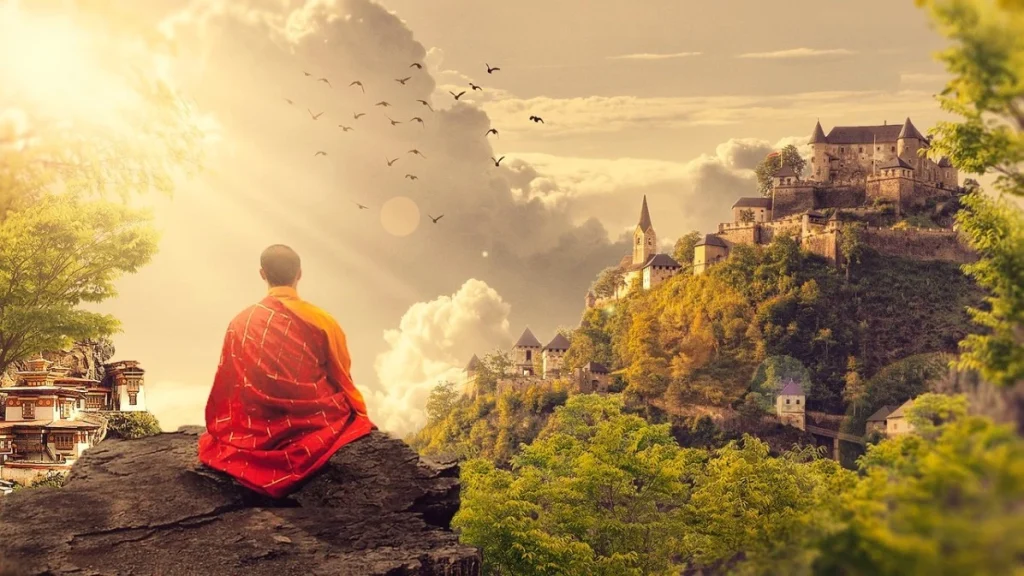
Many tourists are organizing wellness itineraries in 2025, which include spiritual walks through rural India, healing stays, and meditation retreats. These lesser-known villages teach you to live simply, slow down, and rediscover yourself. They are more than just tourist destinations. This comprehensive travel guide covers six of India’s most spiritual villages that genuinely encourage self-healing. 1. Auroville, Tamil Nadu – The Global Village of Conscious Living Why Visit: The concept of unity and inner transformation served as the foundation for Auroville. People come together to live sustainably and mindfully in this international township. Unique Highlight: If you’re into Yoga, meditation, pottery, and eco-workshops, then these all can be incorporated into a visitor’s customized healing schedule. Festivals: To celebrate Auroville Anniversary Day, every February, Auroville hosts meditation events and cultural performances. Foods: Expect plant-based, organic meals prepared using regional ingredients. Pro Tip: To adjust gradually, schedule a 3-day stay. Go to the morning meditation, and spend the evenings at the Matrimandir gardens. 2. Tawang Village Region, Arunachal Pradesh – Peace Amid the Himalayas Why Visit: The rhythm of monastery bells and clean mountain air helps in creating an atmosphere full of healing and mindfulness. It provides a tranquil fusion of natural beauty and Tibetan Buddhist culture. Unique Highlight: Visitors can walk through nearby hamlets, and soak in peaceful mountain sunsets. Participate in morning prayer sessions at the historic Tawang Monastery. Festivals: In January, the Torgya Festival includes masked dances that represent protection and purification. Foods: Enjoy momos, thukpa, and hot butter tea. Its healthy enriched nutrients make it ideal for healing at high elevations. Pro Tip: For peaceful reflection, eat light, drink lots of water, and go to a monastery for evening prayers. 3. Gokarna, Karnataka – The Coastal Sanctuary for Mindful Living Why Visit: Gokarna’s charm is in how it combines spiritual depth with beach tranquility. It is perfect for tourists looking for leisure as well as introspection. Unique Highlight: A leisurely coastal wellness itinerary includes visiting the historic Mahabaleshwar Temple, doing sunrise yoga by the sea, and strolling between beaches along picturesque cliffs. Festivals: Gokarna becomes a hub of devotion during Mahashivaratri. Foods: Try South Indian thalis, banana pancakes, fresh coconut water, Sattvic meals, and herbal teas. Pro Tip: For calm weather, go there between October and March. Reserve lodging close to Om Beach. 4. Rajgir, Bihar – Ancient Healing in the Heart of Magadha Why Visit: Rajgir, a timeless village renowned for its hot springs, Buddhist heritage, and serene hills, was once the capital of the ancient Magadha Empire. It is one of India’s first healing locations. Unique Highlight: Buddha preached at Vulture’s Peak, where you can meditate. You can also take a bath in the Rajgir Kund. Festivals: Every November, music, dance, and spiritual customs come together for the Rajgir Mahotsav. Foods: You stay energized and light throughout the day with simple Bihari meals like litti-chokha, sattu parathas, and seasonal vegetables. Pro Tip: Meditate in the vicinity of the Shanti Stupa. Be mindful of local traditions by wearing modest clothing and taking off your shoes when you’re close to shrines. 5. Meherabad, Maharashtra – A Retreat for Silence and Reflection Why Visit: Meher Baba, who was well-known for his teachings on love and silence, established Meherabad. His legacy is carried on by the village, which welcomes guests looking for simplicity as a means of achieving peace. Unique Highlight: You can read spiritual literature, stroll through peaceful fields, and meditate at Meher Baba’s Samadhi during the day. Festivals: Meher Baba’s Mahasamadhi is celebrated on January 31 of each year during the Amartithi Festival. Foods: Ashram kitchens prepare fresh Maharashtrian cuisine, including jowar roti, lentil dal, and seasonal vegetables. Pro Tip: Schedule your visit during Amartithi Week. Keep a journal with you at all times. 6. Spiti Valley Villages, Himachal Pradesh – The High-Altitude Haven Why Visit: The villages of Spiti, such as Kibber, Langza, and Dhankar, are tucked away in the Trans-Himalayan region and provide an unspoiled setting for profound spiritual healing. Unique Highlight: You can observe the Milky Way’s night sky illumination, learn meditation at isolated monasteries, and stay with local families. Festivals: The Tibetan New Year is celebrated at the Losar Festival with dance, chants, and blessings for rebirth. Foods: Taste warming dishes ideal for mountain climates, such as yak-butter tea, tsampa porridge, and barley soup. Pro Tip: For safer roads, travel between June and September. Bring a tea thermos, sunscreen, and altitude medication. Festivals of Healing Across India Auroville: Peaceful assemblies to foster creativity and solidarity. Tawang: Purification-symbolizing mask dances. Gokarna: The spiritual energy of Mahashivaratri by the sea. Rajgir: Peace festivals that combine music and Buddhism. Meherabad: Silent remembrance of Meher Baba. Spiti: Losar Festival welcoming new beginnings. Pro Tip: For more cultural and spiritual feel, plan your trip especially during regional festivals. Foods That Heal the Soul South India: Coconut-based curries, millets, and herbal teas. Himalayas: For strength, use barley, yak butter, and warm broths. Bihar & Maharashtra: Simple thalis that strike a balance between nutrition and flavor. Avoid overeating or processed food. Eat mindfully, chew slowly, and have gratitude. Pro Tip: Keep a reusable cutlery and bottle with you. Avoid single-use plastic. Travel Planner & Itinerary Ideas Day 1: Arrive in Delhi, Pune, or Guwahati on the first day, then relax. Day 2-3: Go to Gokarna or Auroville for yoga and relaxation. Day 4-5: Travel to Meherabad or Rajgir to participate in meditation sessions. Day 6-7: Conclude in Tawang or Spiti for mountain reflection and stargazing. Pro Tip: Before you travel, always check the climate. Include buffer days in your schedule. Frequently Asked Questions Q1. How long to stay? Three to Seven days. Q2. Are these open to beginners? Yes. It is open to beginners. Q3. When is the best time to visit? October to March. Himalayan villages in June to September. Q4. What is the average budget? ₹1500 – ₹3000 per day except Auroville and Spiti villages. Q5. Are these villages safe? Yes, it is safe. An invitation to slow
Ladakh Travel Guide: Explore the Land of High Passes
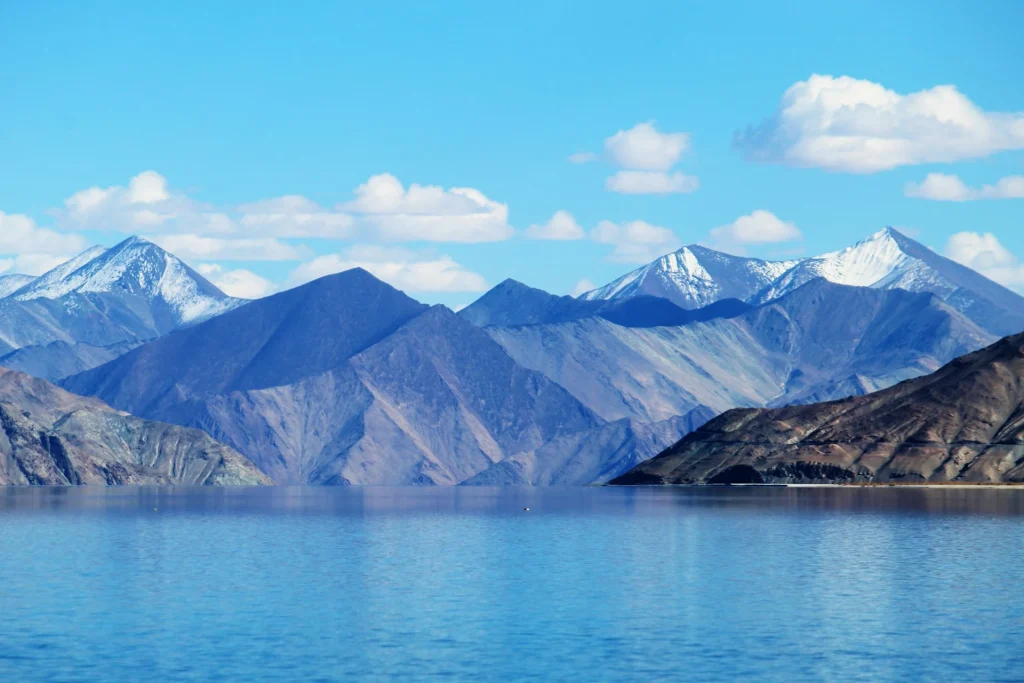
Beginning — Where Heaven and Earth Meet Imagine a desert at a high altitude that is painted in shades of ochre, brown, and deep purple. It is surrounded by the world’s most dangerous mountain ranges. Think of lakes that are the same color as the sky, old monasteries that cling to rocky cliffs, and colorful prayer flags that flutter in the cool, thin air, sending whispers of peace across quiet valleys. This is Ladakh, which means “Land of High Passes.” Ladakh is more than just a place to visit; it’s an adventure that tests the body, inspires the mind, and moves the soul. Ladakh is a one-of-a-kind place for adventurers, spiritual seekers, and nature lovers. This guide will help you find your way around this amazing part of the Himalayas. We will travel across the highest motorable passes in the world, stand in awe at lakes that change color, explore the peaceful world of Buddhist culture, and give you all the important tips you need to plan a safe and unforgettable trip. The Tarzan Way’s immersive storytelling journeys let you responsibly explore the raw, wild beauty of Ladakh while deeply connecting with its landscapes, culture, and people. Are you ready to answer the mountains’ call? Let’s go on a trip to the top of the world. Key Takeaways A Place of Greatness: Find out why Ladakh is known as the “Land of High Passes.” It has some of the highest motorable roads in the world, like Khardung La and Chang La. Iconic Landscapes: Find out about the natural wonders you have to see, like the otherworldly Pangong Tso Lake, the strange sand dunes of Nubra Valley, and the magnetic pull of Magnetic Hill. Spiritual Heartland: Visit the ancient and beautiful Tibetan Buddhist monasteries of Thiksey, Hemis, and Diskit to learn about the peaceful way of life there. Adventure Capital: Learn about exciting things to do, like the famous Chadar Trek, white-water rafting on the Zanskar River, and legendary motorbiking trips. Important Planning and Acclimatization: Learn how important it is to get used to Ladakh’s high altitude and get useful information on when to go, how to get there, and what permits you need. Exploration with care: With help from responsible travel partners like The Tarzan Way, you can learn how to travel mindfully in this delicate ecosystem. Pangong Tso: The Lake That Changes Color Credit: Unsplash The bright blue waters of Pangong Tso are the most famous picture of Ladakh. This saline lake is over 4,350 meters high and runs for an amazing 134 kilometers from India to Tibet. The most magical thing about it is that it changes colors throughout the day, going from blue to green to gray, depending on where the sun is. The Chang La Pass (5,360 m) is a tough part of the journey to the lake. The bare, stark mountains that surround the lake make the area feel very strange and peaceful. Advice for Travelers Plan to spend the night at a campsite near the lake’s shores (in villages like Spangmik or Man) to see the lake’s colors change. It takes about 5–6 hours to get from Leh to Pangong Tso, so leave early. Before going to Pangong, which is even higher, you should spend at least two days getting used to the altitude in Leh. Quick Facts 4,350 meters (14,270 feet) above sea level. Location: It runs along the border between India and China. Type: Endorheic (saline) lake that freezes over completely in the winter. Nubra Valley: The Sky Desert Credit: Unsplash You go down into a valley that feels like another world after crossing the famous Khardung La Pass, which was once thought to be the highest road in the world at 5,602 m. The Nubra Valley is a cold desert at a high altitude that is known for its stunning scenery, silver sand dunes near Hunder, and the one-of-a-kind double-humped Bactrian camels that live there. The Shyok and Nubra (or Siachan) rivers flow through the valley, making it surprisingly green and fertile in the middle of the dry mountains. Another place you have to see is the beautiful Diskit Monastery, which has a huge statue of the Maitreya Buddha looking down on the valley. Why People Want to Go There: It has a beautiful mix of landscapes that you can’t find anywhere else. It is truly unforgettable to ride a camel through sand dunes that are more than 10,000 feet high and see snow-capped peaks in the distance. Advice for Travelers To avoid getting sick from the high altitude, don’t stay at the top of Khardung La for more than 15 to 20 minutes. A camel safari on the Bactrian camels in Hunder is a must-do in Nubra. For a relaxing soak, go to the hot springs in Panamik. A spiritual trip to Ladakh’s old monasteries (Gompas) Credit: Unsplash Ladakh is a stronghold of Tibetan Buddhism. Its landscape is full of beautiful monasteries, or Gompas, that are places of art, spirituality, and learning. Thiksey Monastery: It has a multi-level structure that is often compared to the Potala Palace in Lhasa, Tibet, making it one of the most impressive monasteries. The Maitreya Buddha statue inside is an amazing 49 feet tall. Hemis Monastery: The richest and one of the most important monasteries in Ladakh, Hemis is known for its annual Hemis Festival, which features colorful cultural events and masked dances. Diskit Monastery is the oldest and biggest monastery in Nubra Valley. It has great views and is home to the famous 106-foot Maitreya Buddha statue. Alchi Monastery: Alchi is different because it is built on flat ground next to the Indus River. It is famous for its very old murals and paintings from the 11th century that are very detailed. Advice for Travelers Go to Thiksey Monastery early in the morning, around 6 AM, to see the monks’ deeply moving morning prayer ceremony. When you go to a monastery, wear clothes that cover your shoulders and knees. As a sign of
7 Days in Rajasthan: The Best Way to See the Land of Maharajas
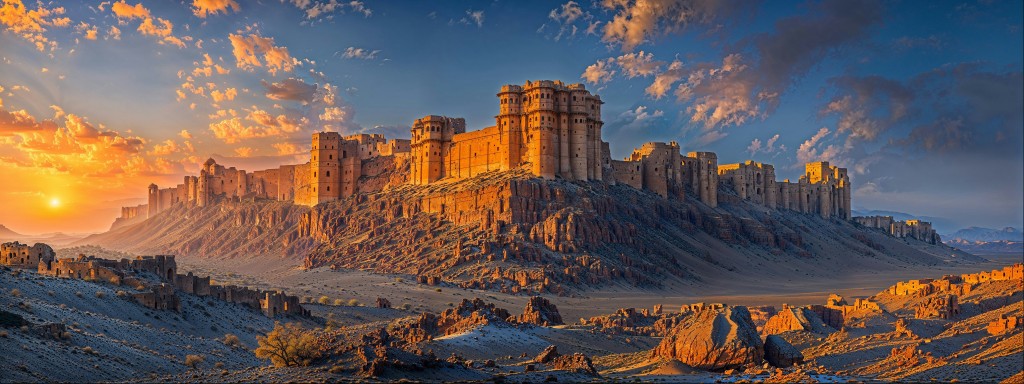
People call Rajasthan the “Land of Maharajas” for a reason. It’s a place where history isn’t just in books; it’s in the huge forts that protect old cities, the beautiful palaces where royalty used to live, and the lively culture that spills out onto every street. When you come here, it’s like stepping into a beautifully illustrated storybook full of stories of bravery, love, and unmatched beauty. I still remember my first trip here—the colours that hit me right away. The men wore bright turbans, the women wore shimmering saris, and the cities were all painted in their own unique colours: Jaipur in a warm blush of pink, Jodhpur in a cool, calming blue, and Jaisalmer in a radiant glow of gold. It’s a traveler’s paradise and a photographer’s dream. But let’s be honest, planning a trip to Rajasthan can be a lot of work. There are so many amazing cities and things to do that it’s hard to know where to start. How do you fit hundreds of years of history into one week? This is where this guide comes in. I’ve made the perfect 7-day Rajasthan itinerary that will give you a deep and rich experience of this amazing state. It includes both must-see sights and opportunities for real connection and discovery. So, get your bags ready and let’s go on a trip through the heart of royal India. A Few Important Tips Before You Go A little planning ahead of time can make your trip to Rajasthan go smoothly and be fun. When to Go: The best time to visit Rajasthan is in the winter, from October to March, when the weather is cooler. The weather is nice and great for seeing the sights. From April to June, the summers can be very hot. Getting Around: Trains and buses connect the state well. The best and most comfortable way to get around on this itinerary is to hire a private car with a driver. This way, you can stop wherever you want. What to Bring: Bring light cotton clothes for the day and a light jacket or shawl for the evenings when it gets cooler. You must have comfortable walking shoes! You should also bring sunscreen, a hat, and sunglasses to keep the sun off of you. A Royal Tour in 7 Days: The Perfect Itinerary for Rajasthan This plan is for a challenging but rewarding trip to Rajasthan’s most famous cities. Get ready for an adventure because it goes quickly! Day 1: Arriving in Jaipur, the Pink City Jaipur, the lively capital of Rajasthan, is where your journey begins. When you first step into the old city, you’ll see why it’s called the “Pink City.” The buildings are all painted a lovely terracotta pink, a colour that means welcome. After checking into your hotel In the Morning, go straight to the famous Hawa Mahal (Palace of Winds). In person, the building’s complicated, honeycomb-like front is even more beautiful. Royal women could watch street parades from this building without being seen. In the afternoon, go to the City Palace to see the heart of royalty. The architecture of this large complex is a lovely mix of Rajasthani and Mughal styles. The current royal family still lives in part of it. Don’t miss the beautiful gates in the inner courtyard; each one is a piece of art. Evening: Get lost in the chaos and colour of Jaipur’s markets. Johri Bazaar is known for its jewellery, and Bapu Bazaar is known for its textiles and leather goods. It’s a great place to buy souvenirs and get a sense of the city’s life. Foodie Corner: For dinner, go to a heritage restaurant like Chokhi Dhani and have a traditional Rajasthani thali. It’s a great way to experience the culture. Day 2: Jaipur—Palaces, Forts, and Stars Today is all about seeing the amazing forts and buildings that are just outside the main city. Get up early In the Morning and head to the beautiful Amber Fort (Amer Fort). This fort is stunning, sitting on a hilltop with a view of Maota Lake. For a truly royal experience, you can walk up, take a jeep, or ride an elephant to the entrance. In the afternoon, go back towards the city to see the Jantar Mantar, an amazing 18th-century astronomical observatory. It’s a UNESCO World Heritage Site, and it’s hard to believe how big and old the tools used to track celestial bodies are. End your day with a stop for a photo at the peaceful Jal Mahal (In the Evening). This beautiful palace looks like it floats in the middle of Man Sagar Lake. It looks especially nice at sunset. Pro Tip: When you go to Amber Fort, it’s a good idea to hire a licensed guide at the entrance. You will have a much more interesting visit if you hear their stories about the fort’s history, secret passages, and the lives of the Maharajas. Day 3: Jodhpur, the Beautiful Blue City Note for travellers: It takes about six hours to drive from Jaipur to Jodhpur. Get up early to get the most out of your day. Welcome to Jodhpur, the “Blue City.” As you get closer, you’ll see a sea of blue houses below the city’s strong protector, the Mehrangarh Fort. In the afternoon, go straight to the Mehrangarh Fort after you get there and check in. In my opinion, this is one of the most beautiful and well-kept forts in all of India. From a rocky cliff, it rises high above the city. The audio guide is great and tells great stories as you walk through the palaces and courtyards. In the evening, walk from the fort to the old city. Walk through the narrow, blue-painted streets and feel the charm of the Middle Ages. The busy Sardar Market near the Ghanta Ghar (Clock Tower) is a great place to end your day. It’s a great place to watch people and try local food. Foodie Corner: You have to
Ultimate Switzerland Itinerary for 7 and 10 Days
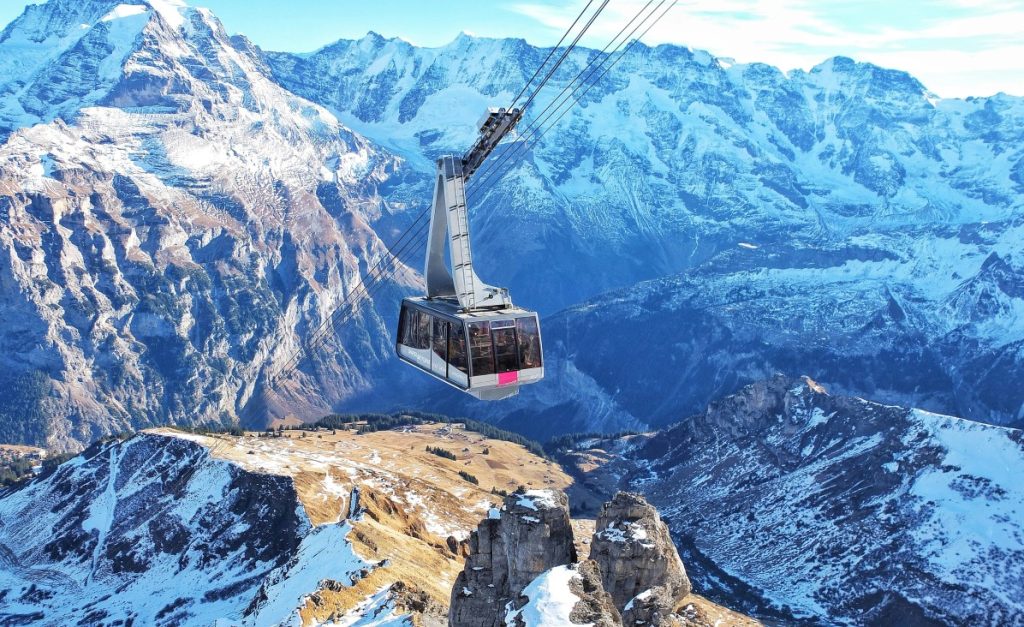
Switzerland is more than just a trip; it is an experience of a lifetime. The fantastic feeling of waking up to cow bells in alpine valleys, breathing the fresh mountain air, and watching the sun shine down on the snowy peaks is life-changing and unforgettable. Whether it is a honeymoon, solo trip, or a family vacation, having a good travel itinerary for travel in Switzerland will make sure you don’t miss a moment. When you have a Switzerland trip planner or curated tour packages you can experience iconic attractions, explore hidden gems, find adventure, and relax on one trip. If you need an example, look to Arjun and Meera from Mumbai, who had the chance to spend 7 days together enjoying Switzerland on their own terms—they went skiing in Zermatt, settled in for sunsets in Interlaken, and explored beautiful cities. Their story illustrates that if you plan thoughtfully, in the end you will have an adventure of several unforgettable moments. Understanding Switzerland – A Country of Contrasts Each Swiss city offers a unique flavor: Zurich: Modern luxury meets historic charm; perfect for shopping, riverside walks, and vibrant nightlife. Lucerne: Picture-perfect lakes, medieval streets, and easy access to Mount Pilatus and Mount Titlis. Interlaken: Nestled between two lakes, ideal for adventure sports and romantic escapes. Zermatt: Home to the iconic Matterhorn, ski slopes, and scenic hikes. Geneva: International culture, serene lake views, and world-class cuisine. The seasons also affect your experience: winter includes snow adventures, while summer includes hiking, festivals, and fun at the lake. You can build your trip around the weather and surrounding festivals to have an unforgettable trip that includes adventure, culture, and relaxation. Suggested 7-Day Switzerland Itinerary Day 1 – Zurich: Explore Old Town, Bahnhofstrasse, and the Limmat River. Evening dining or nightlife options. Day 2 – Lucerne: Walk Chapel Bridge, visit Mount Pilatus or Titlis, and enjoy a lakeside dinner. Day 3 – Interlaken: Paragliding, boat rides on Lake Thun/Brienz, boutique stays for honeymooners. Day 4 – Jungfraujoch: Train to Europe’s highest station, Ice Palace, and Aletsch Glacier views. Day 5 – Zermatt: Gornergrat Bahn, skiing or hiking, fondue dinner in a chalet. Day 6 – Geneva: Jet d’Eau, Old Town, lakeside promenades, and chocolate boutiques. Day 7 – Montreux: Château de Chillon, Lavaux vineyards, lakeside strolls before departure. This itinerary balances cities, mountains, lakes, and cultural experiences without rushing. Extending to a 10-Day Itinerary Longer trips allow exploration of offbeat destinations: Lauterbrunnen: “Valley of 72 Waterfalls” and Trümmelbach Falls. Bern: UNESCO-listed Old Town, Zytglogge Clock Tower, and local cuisine. Lausanne: Olympic Museum, lakeside promenades, vineyards, and wine tours. Gruyères: Famous for cheese, medieval castle, and culinary experiences. A 10-day itinerary offers more immersion, perfect for honeymooners, families, or solo travelers seeking adventure and relaxation. Activities & Experiences Adventure & Outdoor: Skiing, snowboarding, hiking, paragliding, cycling, and mountain biking. Scenic Rides & Water Fun: Glacier Express, Bernina Express, lake cruises, kayaking, and paddleboarding. Cultural Experiences: Medieval villages, local food and wine tours, museums, galleries, and festivals. Curated Switzerland tour packages or a Switzerland trip planner make integrating these experiences simple. Transport, Accommodation & Budget Tips Transport: Swiss Travel Pass covers trains, buses, and boats; panoramic routes include Glacier Express and Bernina Express. Accommodation: Options range from hostels and boutique hotels to luxury chalets and honeymoon packages. Budget Travel: Travel off-peak, use Airbnb or guesthouses, enjoy ready-to-eat meals, and combine destinations efficiently. Honeymoon & Romantic Highlights Switzerland is a top honeymoon destination: Chalet stays in Zermatt or St. Moritz. Scenic train rides on Glacier Express or Bernina Express. Sunset lake cruises and luxury spa retreats. Private wine and chocolate tastings. Packages from The Tarzan Way provide curated itineraries for romance, adventure, and cultural immersion. FAQs & Tips Best time to visit: April–June (spring), July–September (summer), Dec–Feb (winter). Top cities: Zurich, Lucerne, Geneva, Interlaken, Zermatt, Montreux, Bern. Suitability for budget travelers: Yes, with smart planning and Swiss Travel Pass. Trip length: 7–10 days for highlights, longer for hidden gems. Safety: Switzerland is very safe for solo travelers. Switzerland offers the ideal mix of relaxation, excitement, romance, and culture; every traveler will find moments they will remember. Besides beautiful mountains covered in snow, breathtaking lakes, vibrant cities, and relaxing villages, Switzerland is everything a traveler could hope for. You can plan aspects of your trip to Switzerland through an itinerary, guided tour packages, or honeymoon packages that combine all three elements of sightseeing, adventure, and relaxation. Begin your experience and enjoy special moments in memorable landscapes. Ready to plan your dream Swiss adventure? Scroll down to explore the complete Switzerland travel guide and uncover the perfect 7-day and 10-day Switzerland itinerary — featuring breathtaking cities, alpine adventures, scenic train rides, and hidden gems waiting to be discovered. Your Swiss Dream Awaits – Crafting the Perfect Itinerary Waking up to cowbells ringing in the valleys, breathing in the fresh alpine air, and watching the morning sun lightly touch the snow-capped peaks is something magical. Switzerland is not just a place, it’s a sensation. Whether you’re a couple on your honeymoon, a solo traveler, or a family vacationer, a thoughtful Switzerland travel itinerary will help you make the most of your trip to Switzerland. You may sit and sip coffee beside Lake Lucerne, hike in the surrounding Alps, or take a ride on a panoramic train. In Switzerland, with each bend comes another postcard perfect moment. Take for example Arjun and Meera, a couple from Mumbai who were newlywed and wanted to go to Switzerland, they didn’t want to just look at postcards, they wanted to feel Switzerland. With a Switzerland trip planner, they were able to spend 7 days discovering cities, mountains and lakes at their own pace. From skiing in Zermatt to catching a sunset over Interlaken, they found that with a detailed plan and itinerary that it is possible to live innumerable stories in one trip. To make your own dream itinerary come alive, this Switzerland travel guide walks you through everything – from breathtaking cities and



